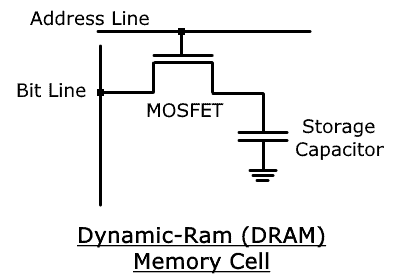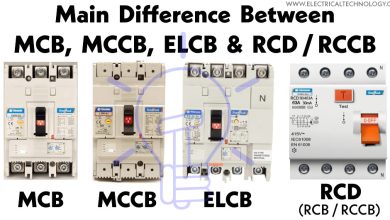Difference Between Static RAM & Dynamic RAM – SRAM vs DRAM
What is the Difference Between Static RAM (SRAM) and Dynamic RAM (DRAM)?
SRAM and DRAM are two different types of RAM (random access memory). Although, both RAM having volatile memory but they are quite different in every other aspect. As a matter of fact, both types of computer memories are used in computers or smartphones at a time. Thus both of them are very important for operation. Let’s know their basics first.
What is RAM?
RAM stands for random access memory. It is a type of primary memory, the memory that is directly accessed by the CPU (more about them in types of memory). The RAM is a temporary memory that stores data temporarily that is frequently used by the processor. It is also called volatile memory because the stored data is erased when its power supply is removed.
- Related Post: Difference Between RAM and ROM – Comparison
There are two types of RAM i.e. SRAM and DRAM.
Static RAM
Static RAM or SRAM is a type of RAM that stores data using flip flops and latches. The flip flop and latches are made up of logic gates that are made up of transistors. They do not require constant refreshing and have very fast speed. Therefore they are used as a cache memory of very small size
The flip flop is the memory cell of a SRAM where each memory cell is made up of 6 transistors. The best thing about flip-flops is that they don’t need a constant recharge to maintain data as there are no capacitors in their design like DRAM.
In static RAM, A single bit of data requires 6 transistors. Therefore the cost per bit is very high. Also, the area occupied per bit is very large. It consumes more power than DRAM due to the large number of transistors. It also generates more heat as opposed to DRAM. Thus SRAM is bulkier and costly. However, they have quite a fast operating speed as they don’t require refreshing.
- Related Post: Difference Between CPU and GPU – Comparison
Dynamic RAM
The DRAM or dynamic RAM is another type of RAM that is used to store data temporarily in its capacitor. Each memory cell is made of a transistor and a capacitor. Due to the leakage current, the capacitor discharges after a moment and cannot retain its data. Therefore DRAM requires frequent recharge to maintain its data. It requires extra circuitry to refresh the memory cell.
The memory cell of DRAM is made of only one transistor and one capacitor. Therefore it has a lower cost per bit as well it takes less space. It consumes less power than SRAM. However, due to the constant recharge, it has a lower operating speed. It has a higher storage density than SRAM.
Differences between SRAM and DRAM
The following table shows the comparisons between SRAM & DRAM.
| Static RAM | Dynamic RAM |
| The SRAM or static RAM is a type of RAM that stores memory temporarily using flip-flop and latches | The DRAM or dynamic RAM is a type of RAM that temporarily stores data using a transistor and capacitor. |
| The memory cell of SRAM is a flip-flop | The memory cell of DRAM is a capacitor |
| Each memory cell is made up of 6 transistors. | Each memory cell is made up of one transistor and one capacitor. |
| It stores data in the transistors. | It stores data in the capacitor. |
| There is no leakage current. | There is a leakage current that discharges the capacitor. |
| It does not require recharging | The capacitor must be recharged to retain data. |
| There is no need for recharging the circuit. | It requires an extra recharging circuit. |
| It has a very fast access speed. | It has a slower accessing speed. |
| It occupies more area per bit than DRAM as it has 6 transistors. | It takes less area per bit. |
| It has a higher power consumption | It has lower power consumption. |
| It is costlier than DRAM | It is cheaper. |
| It cannot be upgraded as it is designed inside the CPU chip. | It can be upgraded as they are available as separate modules. |
| It is larger in size than DRAM. | It is smaller in size for the same capacity. |
| It is used to make the fast-speed cache memory for CPU or DAC. | It is used for its large storage space to design large RAM. |
- Related Post: Difference Between Microprocessor and Microcontroller
Comparison Between SRAM and DRAM
Structure
The static RAM is made up of flip-flops. Therefore each memory cell is made up of 6 transistors.
The dynamic RAM is made of a transistor and capacitor. It has fewer number of components per memory cell.
Recharging Circuit
The static RAM has no capacitor therefore it has no leakage current and it does not require a refreshing circuit.
The Dynamic RAM has a capacitor that discharges due to leakage current and loses the stored data. Therefore extra refreshing circuit is required to recharge the capacitor.
Speed
The static RAM does not need refreshing, therefore it is quite faster than dynamic RAM.
Size
Since static RAM is made up of 6 transistors and dynamic RAM is made of only one transistor, SRAM has a larger size than DRAM.
Cost
The larger number of transistors per bit means a large cost per bit. SRAM is quite costlier than DRAM.
Capacity
The SRAM has a very low capacity and mostly used up to 64 MB. Whereas DRAM has a very large capacity in the range of 16 GB normally
Power Consumption
More components mean more power consumption. Therefore SRAM has more power consumption than DRAM.
Applications
Due to high speed and low memory, the SRAM is only used as cache memory for data that needs to be quickly and most frequently accessed by the CPU.
The DRAM’s large memory makes it suitable for storing temporary data.
Related posts about the comparison and differences between different electrical and electronic components and devices.
- Difference between Analog and Digital Circuit – Digital vs Analog
- Difference between Inverter & UPS – Uninterruptible Power Supply
- Difference Between Inverting and Non-Inverting Amplifier
- Difference Between Amplifier and Operational Amplifier
- Difference Between Inverting and Non-Inverting Amplifier
- Difference Between Amplifier and Operational Amplifier
- Main Difference Between Sensor and Actuator
- Main Difference between Sensor and Transducer
- Difference Between Encoder and Decoder
- Difference Between BJT and FET Transistors
- Difference Between NPN and PNP Transistor
- Difference between Active and Passive Components
- Difference Between Active Transducer and Passive Transducer
- Difference Between Multiplexer (MUX) & Demultiplexer (DEMUX)
- Difference Between Digital Latch and Flip-Flop Circuits
- Difference Between Serial and Parallel Communication
- Difference Between Edge Triggering and Level Triggering









